(CNN) — The world’s biggest tourist playground has been roped off since it became a coronavirus epicenter, but as summer looms Europe is desperate to lift restrictions to get visitors pumping much needed cash into stricken economies.
Across the continent, various nations currently sitting behind the firewall of quarantines or sealed frontiers, are figuring out how they can once again welcome holidaymakers.
Last week, the European Union unveiled an action plan to get its internal borders reopening, safely fire up its hospitality sector and to revive rail, road, air and sea connections that have been strangled during the pandemic.
It’s a situation eagerly anticipated by millions of would-be travelers, desperate to enjoy a slice of European sunshine and culture after weeks or months being sequestered at home under lockdown.
“We all need a break, especially after this confinement,” Thierry Breton, the EU’s internal market commissioner, said. “We want to enjoy summer holidays, we would like to see our families and friends even if they live in another region, in another country.
“But we want to be able to so while staying healthy and safe because we know the virus will stay for us for some time.”
The EU currently has recommendations in place to all its member nations that they restrict all non-essential visitors from outside. But with infection rates dropping off in some countries, this looks set to change.
Some countries, such as Greece and Italy, are already naming specific dates. On Saturday, Italy announced plans to reopen its internal borders next month, while German Chancellor Angela Merkel has said that many internal EU border restrictions would be lifted by June 15.
There’s even talk of permitting special “green corridors” or “travel bubbles” that would allow certain countries with low or sharply declining infection rates to open up to a select few destinations until borders are fully reopened.
Those moves have been backed in the EU plan which proposes lifting restrictions between member states of “sufficiently similar epidemiological situations,” in other words, the same rate of coronavirus infection.
Visitors from outside the EU could still face an indeterminate wait though.
The EU’s plan also sets out a roadmap for developing health and safety protocols for beaches, hotels, campsites, B&Bs, cafes and restaurants to protect guests and employees, such as allowing people to book time slots at the gym or swimming pools in advance.
It also aims to strengthen rules giving travelers the right to choose between vouchers or cash reimbursement for canceled transport tickets or package trips.
EU member states have also agreed to protocols to ensure tracing apps work across borders so that citizens can be warned of a potential infection with coronavirus while traveling within the bloc.
“This is not going to be a normal summer, not for any of us,” said Margrethe Vestager, the vice-president of the EU’s executive arm, the European Commission.”But when we all work together and we all do our part in the ways the Commission is setting out today, then we don’t have to face a summer stuck at home or a completely lost summer for the European tourism industry.”
While these new measures will help impose some order on a somewhat chaotic travel situation across the continent, it remains a fluid situation.
For the time being, if you’re planning to travel to or within Europe in coming months, here’s what you need to know:
France

France is the world’s most visited country, but the coronvirus crisis has cripped tourism here.
PHILIPPE LOPEZ/AFP/AFP via Getty Images
Travelers with France at the top of their list of places to visit once the coronavirus crisis is abating should prepare themselves for a long wait.
From now until at least July 24, anyone who enters the country, with the exception of EU citizens or arrivals from the UK, will be subject to a compulsory 14-day coronavirus quarantine.
However, hotels may be given permission to resume business in the coming weeks.
French hotel chain Accor has closed nearly two-thirds of its hotels, while those that remain open are being used to support healthcare and frontline workers, as well as “vulnerable populations.”
“One piece of good news is the initial recovery of the Chinese hotel market, with mild improvements in occupancy and food & beverage activity: an encouraging tell-tale sign,” a spokesperson for Accor tells CNN.
While waiting for the green light from the government, workers have been “setting stringent safety standards and cleaning protocols,” in preparation for reopening.
Although they aren’t expecting many, if any, international visitors in the coming months, much of Accor’s revenue is from domestic travel, which seems likely to increase considerably if border restrictions stay in place while restrictions are relaxed.
“When the lockdown measures soften, French tourists are likely to want to stay close to home in the short term,” adds the spokesperson.
“It will be the moment for them to rediscover their own country and we will be there to welcome them.”
Greece
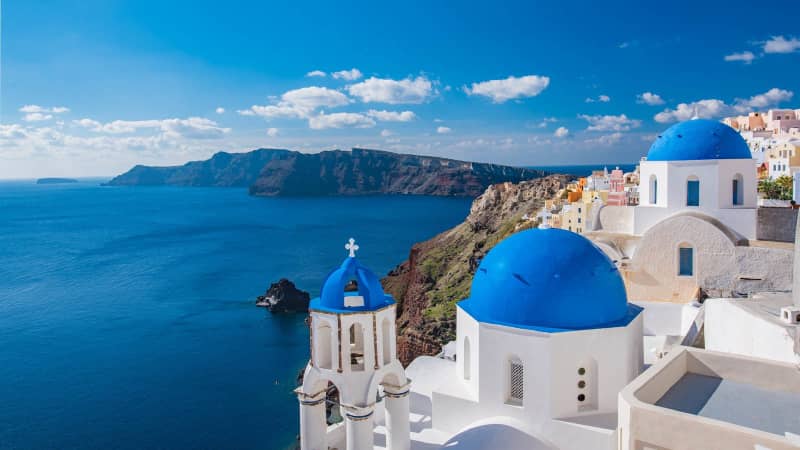
Greece hopes to wlelcome back visitors as early as June.
Russell Yan/Pixabay
Greece may end up becoming one of the first European destinations to open up to tourists again.
The Mediterranean nation has managed to keep its coronavirus death toll remarkably low, with only 150 Covid-19 deaths so far, by enforcing a strict lockdown early on.
Archaeological site the Acropolis, located in Athens, reopened on May 18, along with the country’s high schools and shopping malls.
However, any summer 2020 Greece vacations will be very different to those of past years for obvious reasons.
“The tourism experience this summer may be slightly different from what you’ve had in previous years,” Mitsotakis told CNN earlier this month.
“Maybe no bars may be open, or no tight crowds, but you can still get a fantastic experience in Greece — provided that the global epidemic is on a downward path.”
Greece’s city hotels are scheduled to reopen on June 1 followed by seasonal hotels a month later.
At present, all international passengers must take a Covid-19 test upon arrival in Greece, but Mitsotakis suggests tourists will soon be required to undergo testing before their visit as a further precaution.
While the country may be priming itself to receive visitors again, getting there will prove to be a challenge for most.
However, Mitsotakis is banking on an influx of “more high-end tourists” to help re-energize the country’s tourism industry, which employs one in five Greeks.
Spain
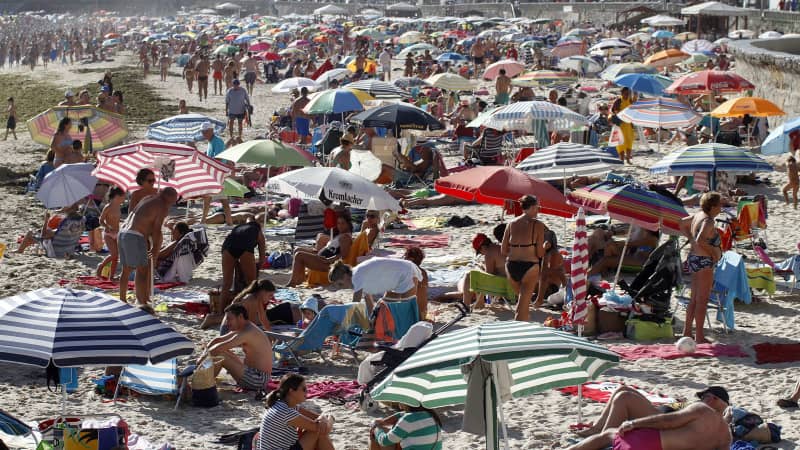
New beach protocols in Spanih town Sanxenxo will involve allocating sunbathing spots on a “first come, first served” basis.
Courtesy Diario de Arousa
Spain’s lockdown proved to be one of the strictest in Europe — children were banned from leaving the house entirely at one stage.
But the popular destination, which welcomed a record 84 million visitors in 2019, is slowly easing restrictions, with beaches set to reopen in June and hotels in some parts of the country granted permission to resume business.
However, officials are understandably cautious about reopening the country, and it seems unlikely the current border restrictions, which ban non-essential travel to Spain for everyone other than Spanish citizens, residents and frontier workers, will change before the end of the summer season.
“The issue of borders will be accompanied by the evolution of the health crisis,” he said.
“Therefore, I do not have the solution of when [they will be able to open]. On how you will be able to enjoy our beaches, we are defining different scenarios.”
One or two of these “scenarios” have already been announced, with a number of towns setting out new protocols to maintain social distancing measures on busy stretches of sand.
Canet d’en Berenguer, a Mediterranean town located just north of Valencia, will only allow 5,000 daily sunbathers on its local beach when it reopens, while Galicia’s Sanxenxo will allocate entry to its beach on a “first come, first served” basis.
Both are roping off small sections on the sands to ensure beachgoers can maintain a safe distance from each other, a move that may well indicate the future of beach visits.
Last week, a senior government official admitted the country’s tourism industry wouldn’t be able to get going again until all internal and external borders within the EU are reopened.
“A big part of our economy depends on the movements of international visitors and of Spaniards,” said the official.
“But we have to have a health system that can take care of anyone who’s in Spain. That’s the fundamental issue.”
Italy

Italy is slowly lifting restrictions after weeks and weeks in lockdown.
ANDREAS SOLARO/AFP via Getty Images
Italy has been one of the destinations worst hit by the pandemic, with a “very long” lockdown imposed back in March, but the Beautiful Country won’t be off limits for much longer.
The Italian government has announced EU travelers will be allowed to enter without having to go into quarantine from June 3 in a “calculated risk” to get the country’s tourism industry moving again.
“We have to accept it, otherwise we will never be able to start up again.”
At present, Italy along with the rest of the EU, currently has restrictions in place on all non-essential travel from outside the Schengen Zone (a grouping of 26 countries that normally have open borders) — apart from the UK.
Travelers from EU countries have previously been required to undergo a two-week quarantine before entering the country.
The announced measures are a major step in the country’s efforts to restart its economy after more than two months of lockdown.
However, nearby Austria and Switzerland still have heavy restrictions in place regarding traveling across the borders, while many airlines have canceled the majority of their flights to Italy, so reopening won’t be a straightforward process.
But officials have made it clear they’re keen to get things moving.
“I have never spoken, nor ever thought, of closing the Italian borders to tourists for 2020,” Giorgio Palmucci, president of the Italian National Tourist Board (ENIT) told local reporters last month. “I am working on the exact opposite.”
All museums, including Rome’s Vatican Museums, are to slowly reopen throughout May. However, strict social-distancing rules will apply, with tickets bought in advance online.
St. Peter’s Basilica in the Vatican reopened on Monday May 18 after being closed for over two months.
Germany

Officials in Germany are in no rush to reopen its borders.
Maja Hitij/Getty Images
Germany has managed to contain its coronavirus fatality numbers somewhat due to substantial testing and contact tracing, but officials have seemed hesitant about letting tourists back in.
Chancellor of Germany Angela Merkel wishes to stop border controls in the Schengen area within weeks.
“The aim is — if the infection process allows it — I want to stress that — that from June the 15th border controls in the Schengen area can be completely eliminated,” she said on Wednesday.
A spokesman for the Austrian Tourism Ministry says the chancellors of the two countries agreed to open the border in a first step for day trippers and commuters. A second step would see a normalized reopening as of June 15.
Germany remains closed to non-EU visitors, while many of its border crossings to neighboring states such as Denmark, the Netherlands, Belgium, Luxembourg, France and Switzerland are either closed or guarded.
Hotels are currently prohibited from accommodating tourists, and the majority of flights to and from Germany remain grounded.
Foreign Minister Heiko Maas has previously expressed concerns about reopening destinations too swiftly, stressing that European countries should come together to decide the best course of action.
United Kingdom

Visitors to the UK are required to go into quarantine for 14 days.
Maja Hitij/Getty Images
The UK government’s decision to introduce a 14-day quarantine on all arrivals just as it begun to ease restrictions for residents has dashed any lingering hopes of reviving international tourism here in the coming weeks.
It’s thought the move, introduced for an indeterminate amount of time, will dissuade airlines from restarting flight operations quickly and officials have warned Brits that their prospects of a summer foreign escape are slim.
Asked in a BBC television interview whether UK citizens should book flights in July, Transport Minister Grant Shapps said: “I’m saying, right now you can’t travel abroad. If you are booking it you are clearly by very nature taking a chance of where the direction of this virus goes and therefore where the travel advice is in the future.”
Under current plans, hotels are likely begin to open in early July, but as EU border restrictions are still in place, it’s expected the UK will focus on domestic travel before any further decisions are made.
Sadly, there’s absolutely no indication of when that’s likely to happen.
Portugal
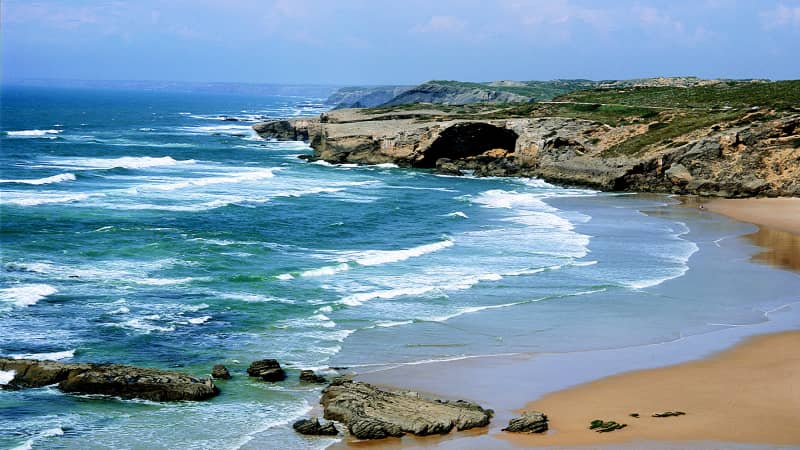
Portugal received 24 million tourists in 2019.
Regiao de Turismo do Algarve
Portugal has also begun to ease its lockdown restrictions, allowing hair salons, dry cleaners and repair shops to reopen.
While it seems doubtful international visitors will be able to return before 2021, the destination has already put measures in place to alleviate the effects.
This applies to all bookings made through accredited travel agencies, as well as hotels or Airbnbs, for trips scheduled between March 13 and September 30, 2020.
Businesses will need to comply with hygiene and cleaning requirements for the prevention and control of Covid-19, in order to receive the stamp, which is valid for one year.
The aim here is to boost the sector’s recovery by reassuring visitors that all efforts are being made to ensure they’re protected.
But like most other European countries, Portugal will have to rely on business from domestic travelers while border restrictions remain in tact.
Croatia

Croatia suffered from overtourism previously, now the destination is keen to get travelers back.
ANDREAS SOLARO/AFP via Getty Images
However, the current limitations on foreign nationals are likely to remain in place until June 15.
Any non-nationals who are permitted entry may be ordered to self-isolate or spend 14 days in official government quarantine facilities “at the expense of the traveler.”
But officials are hoping to work around this by introducing a special “green corridor” between itself and the Czech Republic, another destination with a low number of coronavirus cases as early as this summer.
This would effectively mean any Czech tourists who can provide documentation to prove they’re not infected with the virus would be permitted to travel into Croatia.
Switzerland

A picture taken on from Mont-Pelerin, western Switzerland, on November 20, 2016 shows the cities of Vevey (below) and Montreux (background) on Lake Geneva. / AFP / FABRICE COFFRINI (Photo credit should read FABRICE COFFRINI/AFP/Getty Images)
Fabrice Coffrini/AFP/Getty Images
But that doesn’t mean things have returned to normal when it come to traveling within the country.
Only Swiss citizens and permanent residents, as well as those who have to travel to Switzerland for professional reasons, are currently permitted to enter the country.
Plans to resume domestic tourism industry are moving ahead, with museums, bars and restaurants due to be reopened this week, followed by hotels towards the end of May.
Eastern Europe
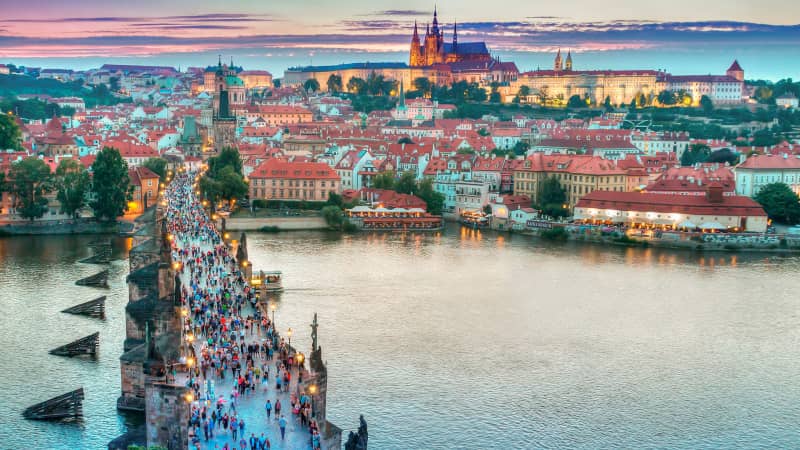
The Czech Republic was one of the first European countries to close its borders back in March.
Pixabay/Creative Commons
Croatia isn’t the only country the Czech Republic is likely to share a “green corridor” with.
Proposals for a similar arrangement with Slovakia, one of the first European countries to ban international passenger travel, are apparently in the works.
Both countries have closed their borders to non-citizens and residents, along with Ukraine, Hungary and Poland, with a mandatory 14-day quarantine required for anyone coming from abroad.
While there’s been no clear indication from the governments of the aforementioned countries on when borders will be reopened, wearing a face mask in public spaces is now compulsory in Poland, Czech Republic and Slovakia.
As the likes of Czech Republic and Slovakia have expressed interest in solely opening up international tourism to less affected destinations, it’s fair to assume officials will be in no rush to welcome travelers from those destinations heavily affected, such as the UK and the US, as well as Spain and Italy.
Scandinavia and the Nordic region

Sweden’s government opted not to issue a lockdown
JONATHAN NACKSTRAND/AFP
As one of the only countries in Europe not to issue a lockdown, Sweden has few restrictions to lift.
However, its borders are still shut to countries outside the EU, EEA, or Switzerland, and these measures are set to remain in place for now.
Deputy Prime Minister Isabella Lovin has admitted the country’s tourism sector has been hit “incredibly hard” by the absence of travelers.
Lovin said it was wrong to suggest the more relaxed approach meant it was business as usual in Sweden.
“A lot of small businesses are on their knees because production is down or has decreased a lot.
“It is not business as usual in Sweden but the opposite, things are very, very tough.”
Nearby Austria is planning a gradual return to normality, with hotels reopening from May 29.
“We would like to offer our guests a wonderfully relaxed stay and of course we make sure that all hygiene regulations are observed,” says Hannes Muller, who runs the hotel.
Meanwhile Denmark plans to lift its remaining lockdown restrictions by the second week of June.
The country’s prime minister Mette Frederiksen has previously spoken of the possibility of reopening borders warning this could move things into “a negative direction.”
“It may help to move the infection in a negative direction. Of course, the borders must also be seen in the context of what is happening in the countries around us.” Frederiksen went on to suggest Denmark would not reopen borders until “at least.”
Iceland brought temporary internal border controls last month, banning all foreign nationals, except for nationals of the EU and associated European countries. Everyone arriving from outside the country has been required to complete a 14-day quarantine since April 24.
The Nordic country is now preparing to reopen in a bid to undo some of the damage caused by the closure.
Iceland’s government expects to start easing restrictions on international arrivals by June 15.
While the full details are yet to be confirmed, it;s thought travelers will be given the choice of a test on arrival or a two-week quarantine.
“Although Iceland is an island, it has always thrived through international trade and cooperation,” Foreign Minister Gudlaugur Thor Thordarson said in a statement.
“With only three cases of the virus diagnosed in May, we are once again ready to carefully open our doors to the world.
“While we remain cautious, we are optimistic as a country that we can successfully begin our journey back to normality.”
Baltic states
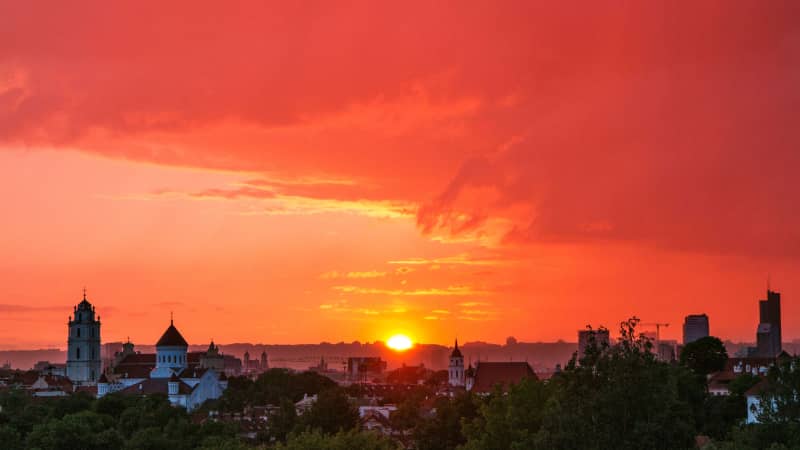
Lithuania is set to join a “travel bubble” with fellow Baltic states Estonia and Latvia.
PETRAS MALUKAS/AFP/Getty Images
The borders for Baltic countries Estonia, Lithuania and Latvia have been largely closed to foreign travelers due to the pandemic.
But as of May 15, each will lift restrictions for each other’s citizens, creating the European Union’s first official “green corridors” or “travel bubble.”
“I think we will keep to this principle when dealing with countries where the situation is very bad, which did not take measures to control the virus spread.
Skvernelis went on to suggest that Poland and Finland may be invited to join further down the line.
However, anyone traveling the countries from outside the “bubble” will be required to go into quarantine for two weeks.
CNN’s James Frater, Max Ramsay, Lindsay Isaac, Stephanie Halasz, Al Goodman, Mick Krever and Elinda Labropoulou contributed to this report.
